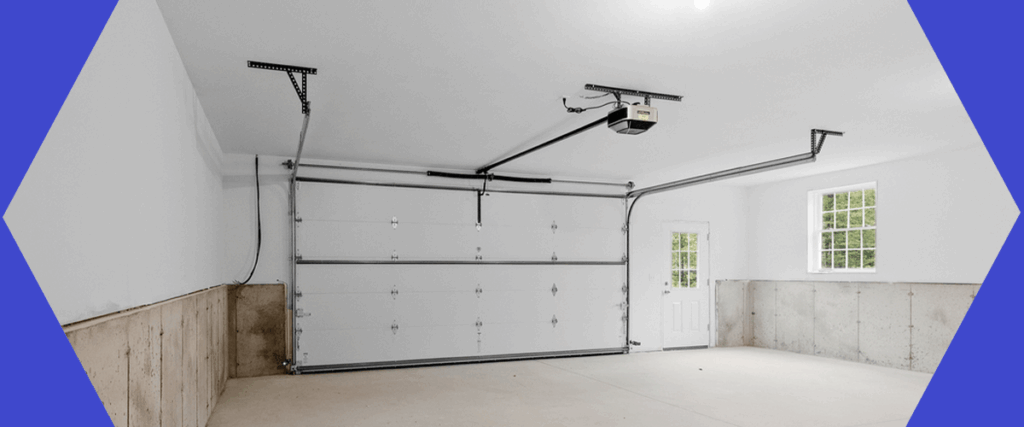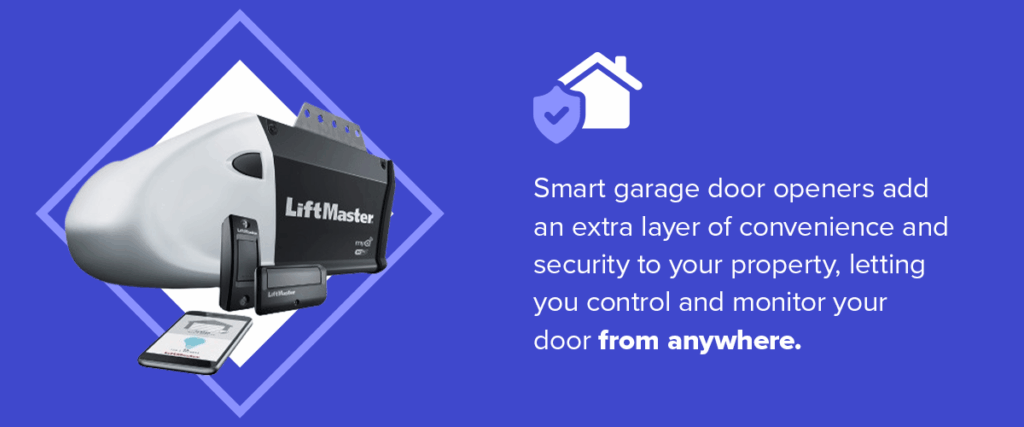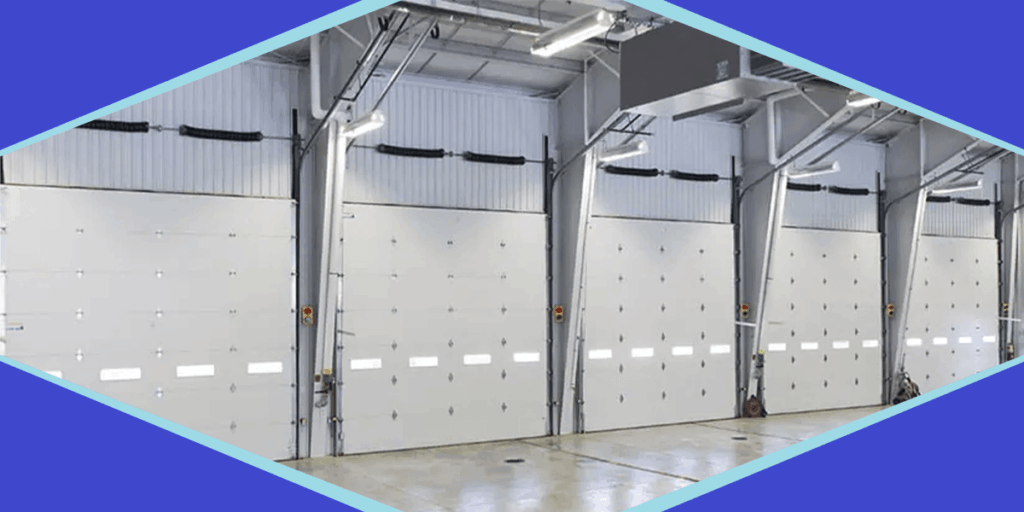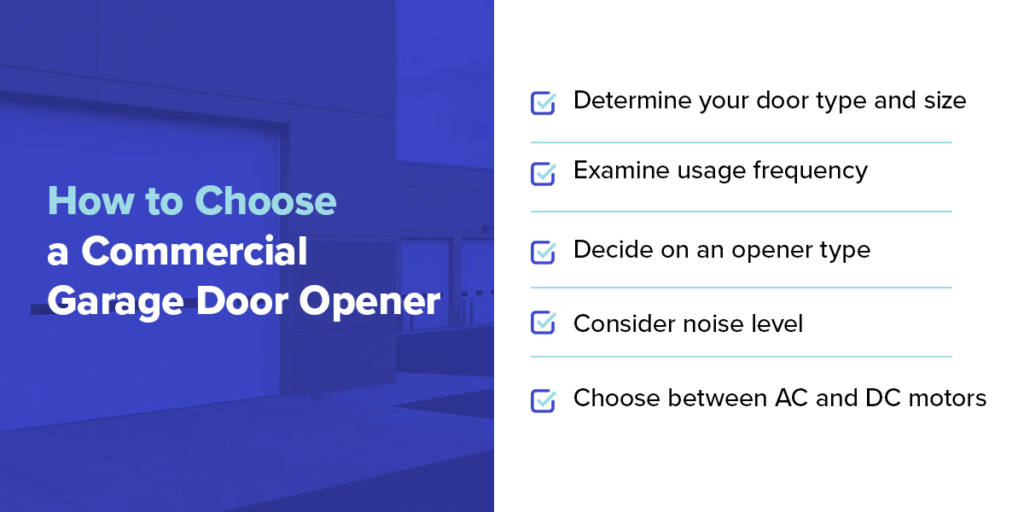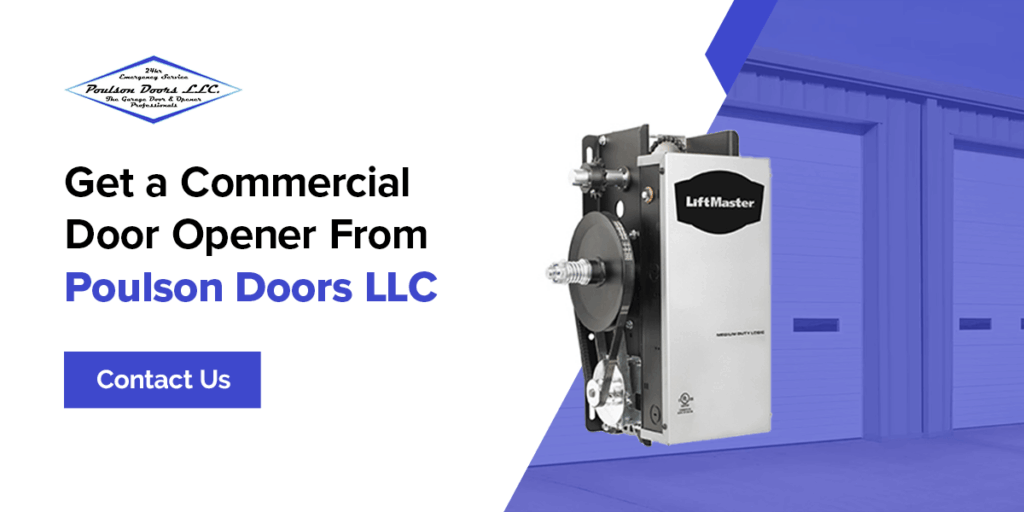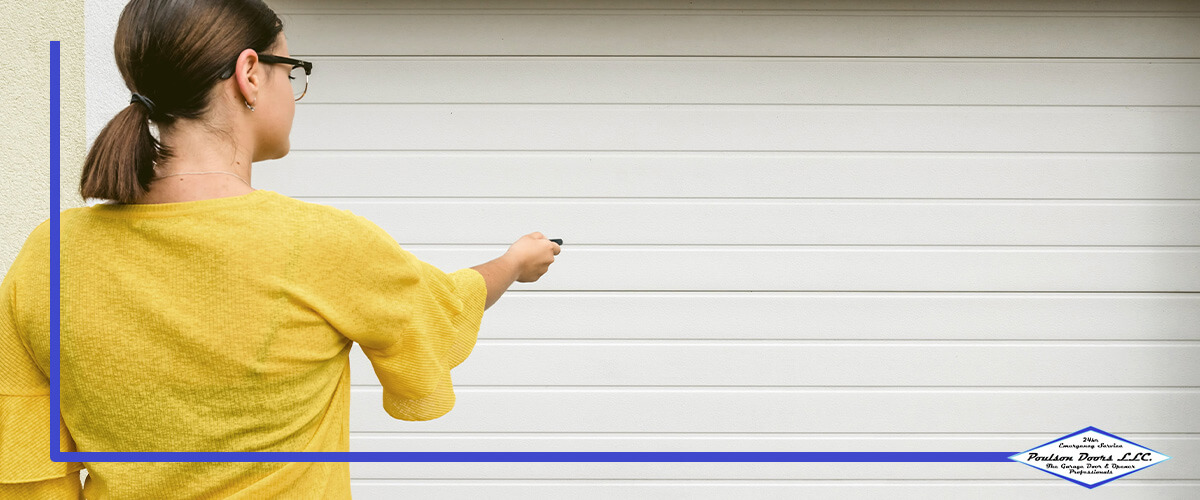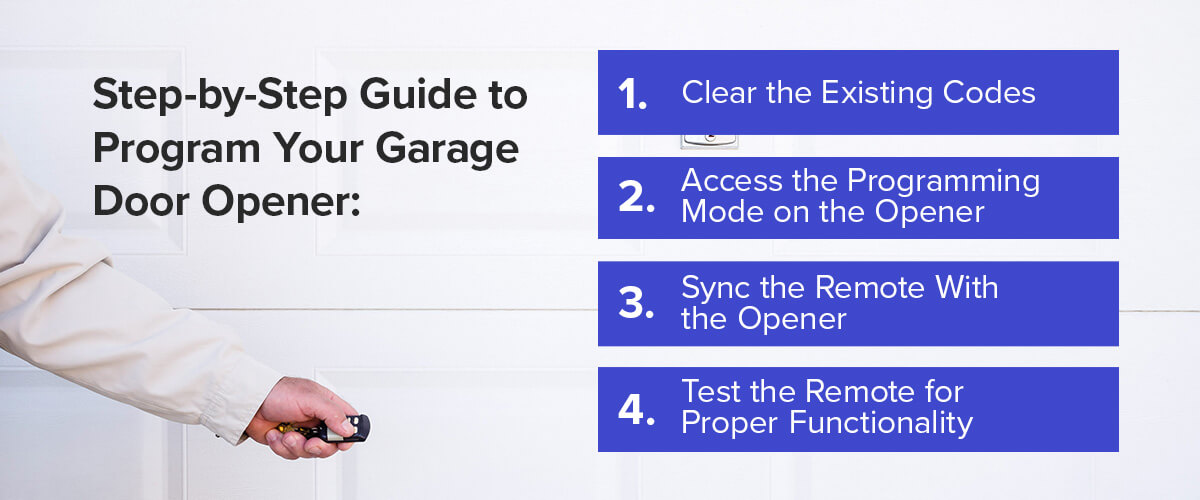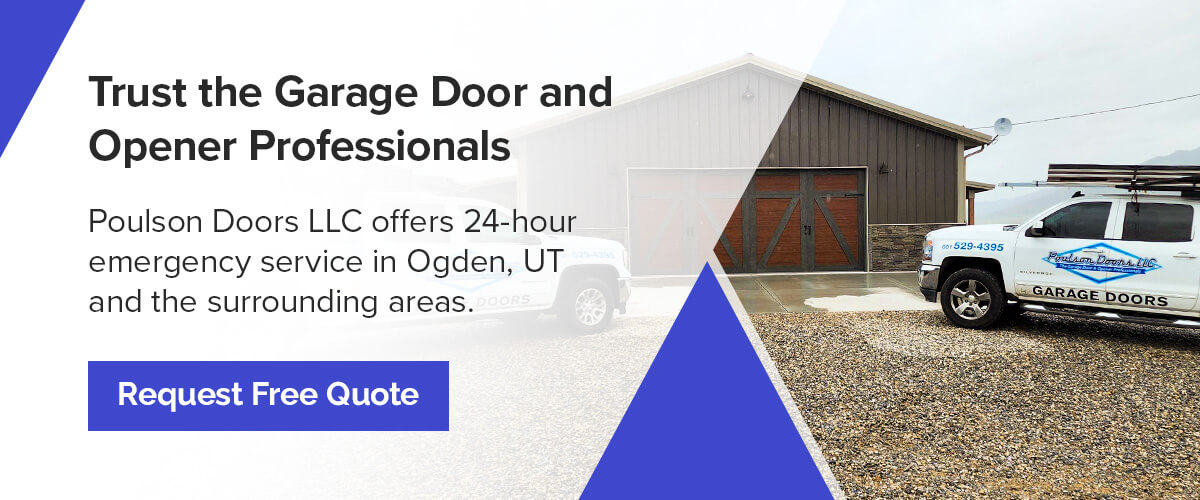The Ultimate Guide to Smart Garage Door Openers
Smart garage door tech makes daily life easier and safer with one‑tap app control, real‑time door alerts and peace of mind when you’re on the go. Knowing how smart garage door openers work, which features matter and typical costs helps you make informed decisions.
With over a decade of experience serving homeowners throughout the Wasatch Front, Poulson Doors LLC offers friendly, expert guidance, quick estimates and pro installation — helping you choose the best smart garage door opener for your home.
How Do Smart Garage Door Openers Work?
Smart garage door openers add an extra layer of convenience and security to your property, letting you control and monitor your door from anywhere. The device is driven by built-in Wi-Fi or a small smart controller that links to an app. A sensor detects whether the door is open or closed, and the app lets you control it remotely, set schedules and sends you instant notifications. Some systems also support secure in-garage deliveries and guest access.
Why Smart Garage Door Openers Matter
Beyond convenience, smart garage door security means knowing exactly who accessed your garage and when, via real-time alerts, activity history and shareable, time‑bound access from your phone. You’ll also notice practical upgrades such as quieter operation with modern belt‑drive designs, bright built‑in LED lighting for better visibility and a battery backup so you can still get in during power outages. Most smart openers connect with popular smart‑home devices and routines, so your garage works seamlessly with the rest of your setup.
Key Features of Top Smart Garage Door Openers
Informed buyers look for options from leading brands with seamless app control. LiftMaster® is a premium choice with built‑in smart features and is the brand carried by Poulson Doors LLC. These openers are known for quiet, durable drives, bright integrated lighting and battery backup options. Many homeowners opt for a Wi‑Fi garage door opener for reliable myQ® app control and easy status checks from anywhere.
Key features you’ll find on LiftMaster® myQ® smart openers:
- Wi‑Fi and myQ® app control supports remote open/close, status checks and easy management from your phone
- Advanced security mechanisms help keep your garage access safer
- LED lighting options provide better visibility with bright, corner‑to‑corner lighting on select models
- Battery backup/standby options ensure uninterrupted operations even during power outages
- A wide variety of options offer choices with designs to fit homeowner requirements and budget
Choosing the Right Smart Garage Door Opener for Your Home
There is a lot to consider when deciding on the best smart garage door opener for your home. Factors such as the weight of your door, noise level, frequency of use, desired smart features and cost will guide the selection process — ensuring the model you choose fits your garage door, lifestyle and budget.
Considerations when selecting a smart garage door opener for your home:
- Features: Pick built‑in Wi‑Fi with myQ® so you can maintain full control of your garage door and manage it from anywhere.
- Security: Prioritize safety and security features for extra peace of mind.
- Lighting: Choose bright, integrated LED lighting to make your garage space safer and more welcoming.
- Power: Add battery backup so the door still works during emergencies.
- Quality: Go with a premium brand like LiftMaster® backed by local pro support from Poulson Doors LLC.
- Budget: Match a model to your budget and needs. Our lineup includes options for every home and homeowner.
Why Choose Poulson Doors LLC for Your Smart Garage Door Upgrade?
Poulson Doors LLC serves homeowners across the Wasatch Front, from Ogden to Provo, with fast response and local support for new installs, repairs and upgrades. Our experienced technicians specialize in smart garage door opener installation and will help you compare options, confirm compatibility and plan the right path for your home.
We sell and professionally install LiftMaster® smart openers with built-in myQ® for reliable app control, strong security features, bright lighting options, and battery backup capability — installed cleanly and configured so you’re ready on day one. Homeowners and businesses trust us for professional, friendly service.
We handle installation, repairs, and maintenance with convenient hours and emergency support, and we provide clear, upfront estimates before any work begins.
Smart Garage Opener Frequently Asked Questions
Are you thinking of upgrading to a smart myQ® garage door opener but need more information? Browse these common frequently asked questions or contact Poulson Doors LLC for more information about your unique requirements.
- Are smart garage door openers worth it? Yes! A smart opener is worth it if you want phone control, door alerts, brighter lighting and power‑out protection. Smart garage door opener costs vary by model and features, and Poulson Doors LLC carries multiple LiftMaster® options to fit different budgets.
- Are smart garage door openers safe? Modern smart openers are designed with safety features such as sensors and required warnings before remote/app closing. Always choose products certified to UL 325 and have them professionally installed to ensure all safety sensors are in place and the opener is used per the manufacturer’s instructions.
- Should I choose a full smart opener or a retrofit? There are many factors to consider when making this decision, such as age and condition of your current opener and door, safety requirements, usage and budget. The best next step is to book a professional inspection and get a recommendation from an experienced technician at Poulson Doors LLC.
- What are some MyQ® alternatives? For compatibility and safety, have a professional confirm your opener and sensors before choosing. MyQ® is the leading smart garage door opener, and alternatives may not give you the dependability or control you want.
- Do I need Wi-Fi in the garage? Smart control garage door openers using the myQ® app need a reliable Wi‑Fi signal in your garage. Some smart garage door openers feature built-in Wi-Fi for smartphone control. If your Wi-Fi coverage is weak, plan for a mesh node or extender to be fitted during the installation. We can confirm network support options and provide an estimate during your initial assessment.
- Can Poulson Doors LLC service and repair Chamberlain garage door openers? Yes! Our skilled technicians have the training and expertise to handle routine maintenance and repairs on all major garage door opener brands. When it’s time to upgrade, we offer a range of LiftMaster® options to pick from.
Get a Free Smart Opener Assessment from Your Wasatch Front Pros
Ready for safer, smarter access? Get a free smart‑opener assessment from your local Wasatch Front experts. Poulson Doors LLC technicians can check compatibility, advise on complete replacement vs. retrofit, explain safety requirements and provide transparent pricing — with same‑week professional installation available.
Request an estimate, or contact Poulson Doors LLC today to upgrade your home’s security, efficiency, and convenience!
The Ultimate Guide to Commercial Garage Door Openers
Commercial garage door openers or operators are motorized devices designed to open and close large doors in industrial settings. They operate different types of commercial garage doors, from sectional models to overhead steel installations. While they closely resemble residential garage door openers, they also possess unique features for commercial use. They’re built to handle heavy-duty and frequent operations.
Our guide provides more insight into the types of commercial garage door openers and how to select one that meets your needs.
Types of Commercial Garage Door Openers
Commercial overhead door operators fall into a few different categories. Here are the three most common types.
Trolley Openers
These are among the most common openers on the market. Their design resembles residential openers — they use a trolley system on horizontal tracks.
Commercial trolley openers are ideal for buildings or warehouse units with sectional overhead doors. You can choose from light-duty, medium-duty and heavy-duty capacities depending on your door’s weight and size.
Jackshaft Openers
Jackshaft openers are designed for vertical mounting instead of overhead mounting, and they go in the side room area beside the door. Many commercial and industrial environments require a lot of vertical space and clearance to ensure easy product and equipment movement, so jackshaft door operators are a popular choice. These commercial door operators are a good option for sectional and rolling doors.
Hoist Openers
Commercial hoist-style door operators are similar to jackshafts in that they are mounted on the wall beside the door. However, hoist operators have a distinct build, which includes a floor-level hoist chain that makes it easy to manually operate the door during emergencies and power cuts. They don’t have an emergency disconnection lever or release cord to trigger manual use.
Hoist openers are generally medium-duty and ideal for lighter commercial doors. They work seamlessly with high-lift and vertical-lift sectional doors, as well as light rolling doors and grilles.
Commercial Overhead Door Opener Drive Systems
A commercial garage door opener’s motor uses the drive mechanism to move the door along the tracks. Two types of drive systems are available:
- Chain drive: These openers use a metal chain connected to the trolley. When the motor operates, it drives the trolley along the rail, lifting and lowering the garage door. Chain drive systems are known for their strength and are well-suited for heavy commercial use.
- Jackshaft system: Jackshaft operators lack the traditional drive mechanism that translates motor power to the trolley. Instead, they mount to the wall and connect directly to the door’s horizontal shaft. The motor rotates the bar to raise and lower the door. A jackshaft system is suitable for rolling doors and various lift designs.
Factors to Consider When Choosing a Commercial Opener
Selecting the right operator for your commercial needs is essential for optimal performance. Consider the following factors as you decide.
Space and Layout
Space is a key consideration when installing an overhead opener. Examine the layout of your facility, particularly the door opening and the available vertical space. If you’re unsure what you need, bring in a garage door expert to help you choose the ideal opener for your layout, door style and door weight.
Horsepower
Garage door openers vary in terms of horsepower. The best commercial garage door opener for you depends on the type and weight of your door and your facility’s typical operation cycles.
LiftMaster operators come in three horsepower categories:
- Light-duty operators: These openers are compatible with smaller and lighter doors. They have a capacity of 25 cycles a day, making them ideal for businesses that don’t frequently operate their doors.
- Medium-duty operators: These are designed for medium-duty use with moderately heavy doors. They’re limited to 50 cycles a day, so they’re most suitable for areas with moderate traffic.
- Industrial-duty operators: These are heavy-duty industrial garage door openers. They have a capacity of 300 cycles a day and are ideal for especially heavy doors and high-traffic facilities.
Safety and Security
Safety and security are key considerations when shopping for a commercial opener. For maximum security, you may want an operator that closes the door after a certain amount of time has passed. It’s also a good idea to look for an opener with an easy, manual operation system in case of emergencies.
Door Speed
Faster openers save time, which is a valuable resource in commercial settings. Speed is important for commercial overhead doors because of its direct impact on efficiency and productivity. High-traffic environments, such as warehouses and loading docks, require fast door operation to minimize downtime and allow smooth workflow.
How to Choose a Commercial Garage Door Opener
Choosing a garage door opener that meets your needs is all about considering your situation and preferences. Here are steps to help you choose the right commercial opener for your business:
- Determine your door type and size: Commercial garage doors vary, from sectional and rolling steel to sliding doors. The size and weight of the door will influence the type of opener you choose.
- Examine usage frequency: The opener you choose will have a per-hour and per-day cycle limit. A light-duty opener is ideal if you operate the door a few times a day, while a heavy-duty opener is suitable for more continuous use.
- Decide on an opener type: Traditional trolley openers are a good choice for sectional doors, while jackshaft openers are the best fit for high-lift and rolling steel doors.
- Consider noise level: Garage door operators have varying features that impact their sound production. Chain drive systems are strong, but they are louder than their jackshaft alternatives. Depending on your business location and specific operations, noise level may be a deciding factor.
- Choose between AC and DC motors: Deciding on your preferred power option is vital because the difference in motor types impacts performance. Currently, the market has alternating current (AC) and direct current (DC) power options. While both offer reliable horsepower, DC motors have an edge over traditional AC motors. They’re quieter, more energy-efficient and more compatible with the latest technologies.
Get a Commercial Door Opener From Poulson Doors LLC
Selecting the right commercial garage door opener is key to ensuring efficiency and smooth operations in your facility. Understanding the different types of openers, drive systems, and horsepower requirements will make the choice easier.
If you’re uncertain about the right product for your needs, consult garage door experts. Poulson Doors LLC is committed to meeting your needs, from commercial garage door opener installation to planned maintenance and repairs. Request an estimate for the opener you like or contact us directly for further assistance.
Step-by-Step Instructions for Programming Your Garage Door Opener
Remember when you had to get out of your car to open and close your garage door? Garage door openers offer the convenience and security of operating your garage from your car. They are energy-efficient, affordable, and safe. Newer models have smart technology that lets you control your garage from your smart device for ultimate peace of mind.
As a homeowner with a new gadget, you want to know how to program your garage door opener. Perhaps you want to know about a specific brand, such as LiftMaster garage door openers. This guide will provide you with step-by-step instructions and tips for maintaining your device.
Understand Your Garage Door Opener System
Before learning how to program your new garage door opener, you want to understand how it works. There are different varieties of openers, including:
- Belt drive: A rubber belt moves the door, making it quieter than other openers. Belt drives are suitable for light or heavy doors and can handle single and double panels.
- Chain drive: A chain connected to the trolley moves the door. The industrial strength of these openers suits heavier doors. They are noisier than belt drives but more cost-effective.
- Smart openers: These are belt — or chain-drive openers with built-in Wi-Fi. You can operate your garage door using your smart device.
Components of a Garage Door Opener System
Here is a rundown of garage door opener components and how they work:
- Motor: This activates the trolley that moves the door up and down. It also controls the distance that the door opens or closes.
- Trolley: Travels on the rail and connects the garage door to the drive mechanism.
- Drive mechanism: Depending on the opener type, the drive connects to the trolley using a chain, screws, or a belt.
- Torsion springs: The springs hold the door’s weight and unwind or wind to raise or lower the door.
- Tube or shaft: An Immobile bar that houses the torsion springs.
- Drums: Pulley wheels attached to the tube that cause cable movement.
- Cables: Wrap around the drums and wrap or unwrap to open or close the door.
- Photo eye or safety reversing release: The sensor prevents injury or damage by reversing the closing mechanism when it encounters an obstruction.
- Emergency release: A quick-release mechanism for manually operating your garage door.
Types of Garage Door Opener Remotes
Just like garage door openers, remotes come in different types:
- Proprietary remote: This is the standard remote supplied with your garage door opener. If you lose it, you can get a replacement from the supplier. You must check your opener’s model number and brand in the manual.
- Universal remote: These remotes work with different opener brands and models. Universal remotes work with radio frequencies, so they don’t rely on codes, and you can operate more than one door with a single remote.
Prepare to Program Your Garage Door Opener
There are a couple of things you need to do before you program your opener:
Locate the “Learn” Button on the Opener Unit
All openers have a “Learn” button that syncs the opener to the garage door. The location of the “Learn” button depends on the brand and model. The square or circular button is green, red, purple or yellow. Find this button either:
- Above the antenna wire on the motor
- Under the light cover
Gather the Necessary Tools and Information
Before you start to program, you will need:
- User manual
- Remote
- Ladder
- Screwdriver
Step-by-Step Guide to Program Your Garage Door Opener
It’s time to program your garage door opener! Follow these steps:
1. Clear the Existing Codes
The opener may have old or default codes. To clear existing codes, press and hold down the “Learn” button until the light goes off.
2. Access the Programming Mode on the Opener
Press and release the “Learn” button to activate programming mode. For MyQ control panels, press and release the “Learn” button twice to access this mode.
3. Sync the Remote With the Opener
Press and hold the remote control button within 30 seconds of activating the programming mode. The garage door opener’s lights will flash or you will hear two clicks. The control is now synced.
4. Test the Remote for Proper Functionality
Press the button on your remote to ensure it opens and closes the garage door as expected.
Troubleshooting Tips for Common Issues
Like any electronic device, garage door openers may encounter issues. Common problems include the remote not syncing with the opener or the opener not responding to remote commands.
Here are some solutions you can try:
- Replace the remote batteries: Replace the batteries every one to two years. After replacing the batteries, you may need to reprogram the remote control.
- Deactivate the lock button: Check the lock button on the control panel. Press and hold it to deactivate.
- Investigate disrupted signal: Ensure you’re in range when clicking the remote and check for any obstructions between the remote and door sensor.
- Inspect the antenna: Check for debris, damage, or incorrect positioning.
- Reset your garage door opener: Follow the steps above to reset your garage door opener.
If the above steps don’t solve the problem, it may be due to a door wiring malfunction or a damaged antenna. In this case, you should contact garage door repair professionals for help.
Explore Additional Features and Settings
Garage door openers have other features to explore.
Set up Keyless Entry Pad Codes
Set up a personal identification number (PIN) for your garage door in three easy steps:
- Find the “Learn” button on the garage door opener.
- Press and release the “Learn” button so the LED light glows.
- Enter your 4-digit PIN within 30 seconds. Press and hold the “Enter” button until the opener light flashes.
Program Your Opener in Your Smartphone
Garage door openers compatible with myQ features allow you to download an app and control your garage door from your smartphone. You can open, close, and monitor your garage from the myQ app on your phone, whether you’re at home or away.
Maintenance Tips for Optimal Garage Door Opener Performance
Now that you’ve programmed your garage door opener, you’ll want to maintain it so that it performs for years to come!
Here are four quick tips to keep your garage door opener in top condition:
- Change the remote batteries every year or two.
- Clean the safety sensors with a soft cloth and a gentle cleaning solution to remove dust. Check their alignment regularly.
- Tighten any loose nuts, bolts, and screws on the garage door opener.
- Lubricate metal or moving components, such as springs or rollers.
Safety Precautions When Programming Your Garage Door Opener
Your garage door opener is there to make your life easier and safer. Some safety precautions to keep in mind when you program your opener are:
- Ensure proper installation and functioning of safety sensors: The sensors keep people, animals, and objects safe from the closing door. Follow proper instructions when you install the safety sensors.
- Test the reverse mechanism after programming: Place a block or a one-inch board on the floor under the open garage door. Use the remote to close the door — it should reverse when it hits the obstruction.
Trust the Garage Door and Opener Professionals
If you need help with any garage door-related matters, such as installation, replacement, repair, or maintenance, contact Poulson Doors LLC. Customer satisfaction and education drive everything we do! Poulson Doors LLC offers 24-hour emergency service in Ogden, UT, and the surrounding areas. Call us or request a free quote today.
How to Reset a Garage Door Opener
Automatic garage door openers are relatively straightforward devices, though they’re incredibly innovative home features that make daily life more convenient. There’s no need to open the garage door manually, reverse out to the driveway, and then get out of your car to manually close the door before leaving your home. Instead, you can open and close even the heaviest garage doors with a button.
Still, garage door openers can experience issues. Sometimes, resetting the device can restore smooth function. The device’s manual should walk you through this process. If you have misplaced your manual, keep reading to learn the simple steps for a garage door opener reset.
Reasons to Reset a Garage Door Opener
A reset might suffice if your garage door opener won’t work or the remote or keypad seems faulty. Try resetting the device before searching for emergency garage door services in your area.
The Garage Door Remote or Keypad Is Not Working
Sometimes, your remote or keypad might not work because the device’s batteries are dead. If replacing the batteries does not restore operation, resetting the device might if the sensitive tech inside has lost its programming signal. However, it might be time for a replacement if your remote is older than a decade.
You Lost Your Remote or Forgot the Code
Misplacing keys and remotes is child’s play, and you may forget your passcode if you’ve recently moved or are returning home after a long absence. Fortunately, you don’t need to call an emergency locksmith in these situations — you can quickly reset your garage door opener.
If you have lost your remote, reset the garage opener to reprogram its replacement. On the other hand, if you have forgotten the passcode for an opener with a keypad, you can reset the device at the control panel to program a new one.
You Have Moved or Suspect Suspicious Activity
Because automatic garage door openers connect wirelessly to their remotes, criminals can use hacking technology to copy your remote’s programming signals and program a new remote to open your garage door. This method is a common way intruders break into properties, even those with extensive home security measures.
Regularly resetting your garage door remote is the best way to safeguard your home. Resetting the device will wipe its programming signals, ensuring a previously duplicated remote won’t work.
At the same time, resetting the opener and remote or keypad is worthwhile if you have moved. You won’t want previous residents or anyone else accessing your property through the garage, so it’s best to reset the device.
How to Reset Your Garage Door Opener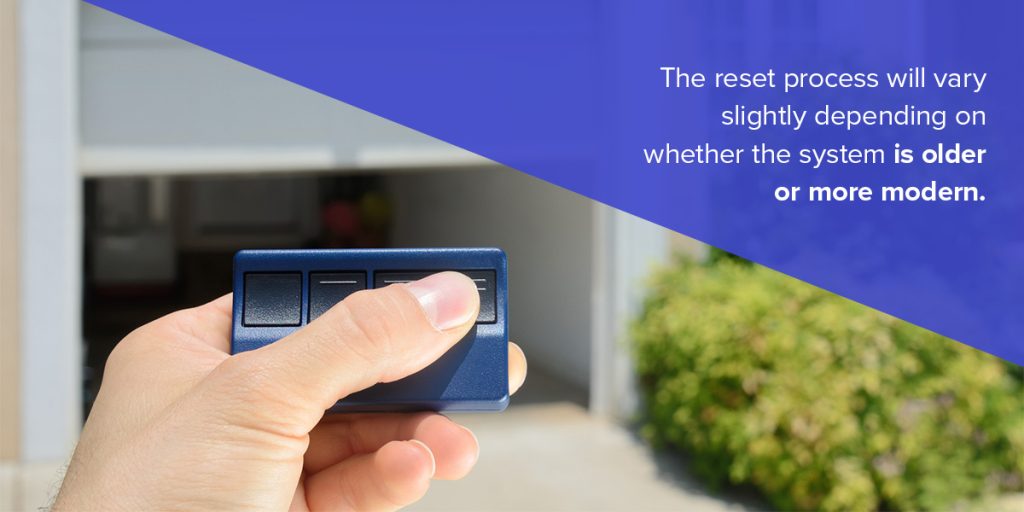
The garage door reset process will vary slightly depending on whether the system is older or more modern. Here’s how to reset a garage door opener.
You must remove the outer casings on the remote and opener for older systems with nine to 12 switches inside the unit and a handheld remote. The switches on both devices must match for the remote to connect with the opener. If they don’t match, use a pen or tweezers to manually change the switches so they are identical.
Newer garage door opener systems have a “home” or “learn” button on the central unit. This button is usually near an LED light or the unit’s antenna. The process to reset new garage door opener systems can vary slightly across different models, but in most cases, you will need to press and hold the “home” or “learn” button for roughly five seconds or until the LED light begins to blink. Press the remote to link the light to the opener while the light is blinking.
If you have a newer system with a keypad, press the “home” or “learn” button before entering a new passcode. Wait for the light to change to indicate that the code has taken effect, then test the new code.
Signs You Need to Replace Your Garage Door Opener
Sometimes, a quick reset can restore functionality for your garage door opener. You might need to schedule a professional repair or replacement in more severe cases.
Here are some typical garage door opener issues that may indicate you need a new system.
- The garage door came off the roller: In this situation, the door might jam as it slowly forces its way open or closed, or it may not even budge. A professional garage door technician must fit the door back onto the rollers and balance the door after ensuring the rollers are in good working order.
- The door hesitates to open and close: You will need to replace the system soon if you press the remote or punch in the passcode and the garage door won’t open or hesitate to open or close.
- The door randomly opens, closes, or changes direction: When garage door opener systems near the end of their life span, it’s not unusual for them to behave strangely. The door may open or close randomly, get stuck halfway, or change direction despite no obstructions in the sensor beam.
- The opener works extremely slowly: An extremely slow-moving door is another surefire sign that it’s time to contact a technician for repairs or replacement. You could have damaged springs, an off-balance door, or need lubrication for moving parts.
- The motor is faulty: Garage door openers can last up to two decades if kept in good condition. However, the motor can wear out sooner due to daily use. If this is the case, it will be louder than usual.
Troubleshooting a faulty garage door opener system can take time and effort. Fortunately, our expert technicians can quickly diagnose the problem and offer a free quote for repairs or replacement.
Contact Poulson Doors LLC for Garage Door Opener Repairs and Replacement
Whether your garage door opener is noisy or not working, our garage door and opener professionals can restore function. We understand garage door problems are urgent and often a safety concern, so we offer same-day and 24-hour emergency services.
Contact us today to request a free estimate or schedule an appointment. Visit our website to learn more about our residential and commercial services.

